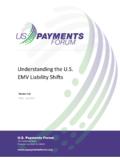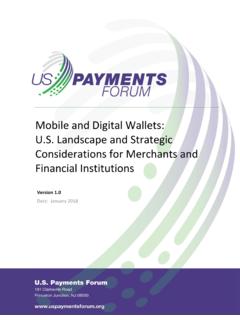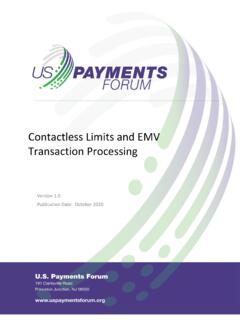Transcription of EMV Troubleshooting Guide for ATM Owners and …
1 Payments Forum 2017 Page 1 EMV Troubleshooting Guide for ATM Owners and Operators Version Publication Date: November 2017 Payments Forum 2017 Page 2 About the Payments Forum The Payments Forum, formerly the EMV Migration Forum, is a cross-industry body focused on supporting the introduction and implementation of EMV chip and other new and emerging technologies that protect the security of, and enhance opportunities for payment transactions within the United States. The Forum is the only non-profit organization whose membership includes the entire payments ecosystem, ensuring that all stakeholders have the opportunity to coordinate, cooperate on, and have a voice in the future of the payments industry.
2 Additional information can be found at About the ATM Working Committee The Payments Forum ATM Working Committee explores the challenges of EMV migration for the ATM industry, works to identify possible solutions to challenges, and facilitates the sharing of best practices with the various industry constituents, with the goal result being more positive EMV migration experience for consumers. EMV is a trademark owned by EMVCo LLC. Copyright 2017 Payments Forum and Smart Card Alliance. All rights reserved.
3 The Payments Forum has used best efforts to ensure, but cannot guarantee, that the information described in this document is accurate as of the publication date. The Payments Forum disclaims all warranties as to the accuracy, completeness or adequacy of information in this document. Comments or recommendations for edits or additions to this document should be submitted to: Payments Forum 2017 Page 3 Table of Contents 1. Introduction .. 4 2. Preventing Common Transaction Problems .. 4 Ensuring Data Integrity.
4 4 Chip Cards at a Non-Chip-Enabled ATM .. 4 Chip Cards at a Chip-Enabled ATM .. 5 Monitoring Transaction Activity .. 6 Additional 7 3. Troubleshooting Tips .. 7 Determine the Scope of the Problem .. 7 Watch for Possible Problem Scenarios .. 8 All Transactions Are Being Sent as Fallback .. 8 Declined Transactions .. 8 Issuer Declines for an EMV-Related Reason .. 8 EMV Chip Transaction Reversal .. 10 Helpful Tips .. 10 Helpful Resources .. 10 4. Legal Notice .. 11 5. Appendix 1: Application Selection.
5 12 Payment System Environment (PSE).. 13 Explicit Selection (Also Known as List of AIDs) .. 13 Common Debit AID .. 13 Payments Forum 2017 Page 4 1. Introduction The implementation of EMV at ATMs continues at a steady pace. Many ATM Owners and operators are now beginning to feel the impact of the ATM liability shifts. ATM Owners and operators are seeing new transaction scenarios and are at risk of incurring chargeback and fallback penalties. This document provides recommendations to help ATM Owners /operators prevent some common transaction problems, and offers suggestions for Troubleshooting problems when they do occur.
6 This document will not cover the dispute process ( , chargebacks, re-presentments), since the requirements and policies of industry stakeholders may vary. Consult with the acquirer processor or payment network for specific information about rights and obligations surrounding the dispute process. The hardware required to support EMV varies based on the ATM manufacturer and model; however, the ATM provider has the responsibility to ensure that all hardware is EMV capable prior to starting EMV implementation. A recommended best practice is to test the EMV implementation prior to production implementation.
7 This may require test cards1 with each Application Identifier (AID)2 supported by the ATM processor. The ATM provider should coordinate testing of EMV functionality at their terminals with their ATM independent sales organization (ISO) or processor, and should explore acquisition of any available test cards with their ATM ISOs or processors, and/or directly with the payment networks. 2. Preventing Common Transaction Problems Common transaction problems can be prevented by taking steps to ensure data integrity and by monitoring transaction activity.
8 Ensuring Data Integrity It is vital that the data in the transaction request be as accurate as possible, so that an issuer can make the correct authorization decision. An issuer may decline a transaction if transaction data is inconsistent or potentially inaccurate. Chip Cards at a Non-Chip-Enabled ATM An ATM that supports only magnetic stripe cards is unable to read the chip on a card. These ATMs can still accept a chip card but the ATM operator will be liable for counterfeit transactions processed on a chip card. ATM operators should ensure that: The Track 2 data, including the primary account number (PAN), service code, expiration date, and card security code, is captured from the magnetic stripe and sent as is ( , unchanged) in the transaction request.
9 1 Not all payment networks require physical cards for testing and certification. 2 See Appendix 1 for information on AID Selection; for information on the Common Debit AID selection, see the Implementing EMV at the ATM: Requirements and Recommendations for the ATM Community white paper. Payments Forum 2017 Page 5 The POS Entry Mode accurately reflects the ATM entry capability (magnetic stripe) and that the data was read from the magnetic stripe. The transaction code in the request is appropriate for the action being performed ( , withdrawal).
10 Chip Cards at a Chip-Enabled ATM Prior to deploying or upgrading an ATM in the field, the ATM owner /operator should verify that: A valid EMV kernel has been installed prior to loading AIDs. Check with the manufacturer, distributor or other supplier to confirm that the kernel is properly certified and that the certification is current. The correct AIDs are configured in the ATM. Obtain and maintain the current AID list from the processor, ISO, and/or manufacturer and make certain that the AIDs are properly loaded in the terminal software.



